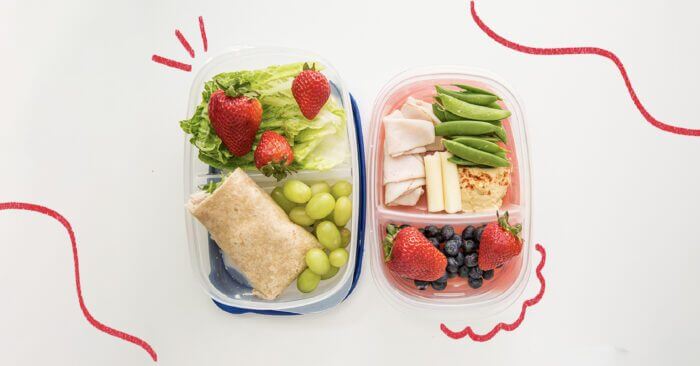WANT EVEN MORE HEALTHY IDEAS FROM SHAPE YOUR FUTURE?
Healthy living is so important for teachers, but it can also feel very intimidating. Shape Your Future sat down with the 2023 National Teacher of the Year, Rebecka Peterson from Union High School, to discuss the benefits of personal health and realistic ways teachers can eat better, move more and make healthy choices during the school year.
Snack healthy on the clock.
As every teacher knows, most school days are overflowing with lessons, duties, meetings and activities, leaving very little time for a sit-down lunch. If your busy schedule makes healthy choices feel impossible, pack your desk with healthy snacks. Prepackaged options like unsalted nuts, string cheese, whole grain pretzels and raisins are easy to grab and munch on during passing periods or while grading papers. “I don’t want to be hangry in front of my students!” said Rebecka. “Having a quick snack during passing periods can help me feel calmer and more in control.”
If you want to eat more fruits and veggies, try buying, washing and chopping all your produce over the weekend. Apple slices with peanut butter and berries with Greek yogurt are tasty ways to add protein to your snack breaks. No time to chop? Oranges, bananas, baby carrots and celery sticks are fresh options that don’t require prep work.

Keep lunchtime simple.
On days when you do get a lunch break, opt for something easy so you can spend more time enjoying your food and less time waiting in line for the microwave. Mix-and-match lunch packs are quick to prep and easy to eat. Toss any combination of fruits, veggies, hard-boiled eggs, hummus, whole grain crackers, turkey slices and other healthy items into a to-go container for a lunch you can enjoy anywhere. Rebecka said, “Lunch is the only part of my school day that I get to interact with other adults, and it’s important that it stays that way. I do my best not to work during this time but instead enjoy a respite with my colleagues. I pack a lot of sandwiches or leftovers that heat up quickly so I can get as much time as possible with my peers.”
On lunch duty? Wrap up your lunch … literally! Wraps are a great option to eat while you’re on your feet. Try one of the recipes below, or craft your own using your favorite protein, sauce and veggies.
Sneak movement into your schedule.
A little bit of movement goes a long way. If you find yourself sitting more than normal, take five to ten minutes wherever you can find it to loosen your muscles and get physical. If you’re on recess duty, do calf raises at your post or walk the circumference of the playground while you monitor your students. On off-duty days, walk the halls or do a few small stretches at your desk.
If you teach high school, recess workouts are probably not an option for you. Instead, walk the halls with your students during passing period or start up a movement motivation group with other teachers for accountability outside of work. Rebecka said, “I want to do math with my students, not at them. This means that I’m rarely at my desk or even up at the board; instead, I’m walking around the room, checking for understanding and building rapport. I love that this job is not a sedentary one. Are my feet tired at the end of the day? Yes. But I’m grateful for that. I’m grateful for a vocation that affords movement, autonomy and creativity.”

Get the students involved when possible.
Students need movement, too! If lower-elementary kids don’t get the wiggles out on the playground (or if the weather is keeping them off the playground), try one of these workout videos to expel the leftover energy and scare away the afternoon sleepies.
Older kids are probably less willing to move with bright characters and upbeat music; however, movement is still important as they age. Taking a moment at the beginning of class or after the lesson to stretch may feel silly at first, but it can help your students focus and prime their brains to do quality work. “Students are human beings first,” said Rebecka. “In order to do our jobs well, we have to think about the whole student. Many of my high schoolers report feeling stressed and anxious. So, we take a little bit of time at the beginning of each week to practice breathing exercises — to practice being in the present, not worried about the past or stressed about the future. It’s helped me become more mindful about taking care of my physical and mental health. Additionally, research shows that if we offer our students brain breaks, the content they absorb is more likely to be stored into their long-term memory.”
Your influence in the classroom is powerful. By modeling healthy living in front of your students, you’re encouraging them to lead healthier lives. Check out this blog for encouraging tips!
Practice mindfulness when you can.
Mental health is just as important as physical health. Every day, teachers make a ton of decisions and supervise dozens (or possibly even hundreds) of kids. “Something that comes as a surprise to non-educators is that teaching can be really lonely,” said Rebecka. “Many of us don’t get much interaction with other adults; some of us don’t have colleagues with whom to collaborate; others might be new to the building or just haven’t found their teacher besties yet.” If you’re running on empty, your work, mood, appetite and productivity will all be affected. Here are a few simple ways to invest in your mental health:
- Connect with fellow teachers. Your best resource is often in the classroom next door. If you’re feeling lonely after chatting with students all day, reach out to a fellow adult who may be feeling the same way.
- Get plenty of sleep. Many overlook sleep as an aspect of healthy living, but it is vital to your overall health. Check out the following blogs for tips to adjust your sleep schedule and improve sleep quality.
- Take mindful breaks throughout the day. Not every break has to involve cardio to be healthy. Sometimes, all you need are a few deep breaths. If you’re looking for a free guided option you can do during the workday, check out these resources from the Oklahoma Tobacco Helpline.
Remember: When you take care of yourself, you are better equipped to take care of your students. Healthy living looks different for everyone, and perfection is not necessary! So, find the options that work for your lifestyle, schedule and interests — and start living a happier, healthier life!
Hungry for more classroom resources? We have plenty!





